If you've ever wondered whether or not YouTubers actually make money, the answer is a resounding YES. Some earn a side income or use it to promote their full-time business. Others turn content into a full-time job. A small handful make millions.
In fact, the platform paid out more than $70 billion to artists, creators, and media companies in the three years leading up to 2024. And in 2022, its creative ecosystem contributed more than €5.5 billion to the EU's GDP. The platform now has 2.7+ billion active users, and its user base is growing every single day (a.k.a. more opportunities for payouts).
But your earnings depend on a mix of factors: niche, audience size, watch time, monetization strategies, and even geography.
In this article, we’ll break down exactly how YouTube creators make money, what kind of income you can realistically expect at different levels, and what it takes to scale to the big leagues.
- YouTube ad revenue, explained
- How to qualify for the YouTube Partner Program in 2025
- Top factors that influence YouTube earnings
- YouTube earnings data, case studies, and analytics
- Estimating your potential YouTube earnings
- Costs of running a YouTube channel
- How to maximize your YouTube earnings
- Common challenges of making money on YouTube
- Final thoughts and action steps
YouTube ad revenue, explained
Before we get into how much you can earn, it helps to understand how YouTube makes its money because that’s the pool your earnings come from.
YouTube is, at its core, an ad business. When you post content, you're giving YouTube inventory — that is, space where they can place ads. The better your video performs, the more ad slots it creates, and the more money they make.
In return, they share a cut of that revenue with you.
AdSense: The engine behind YouTube's creator payouts
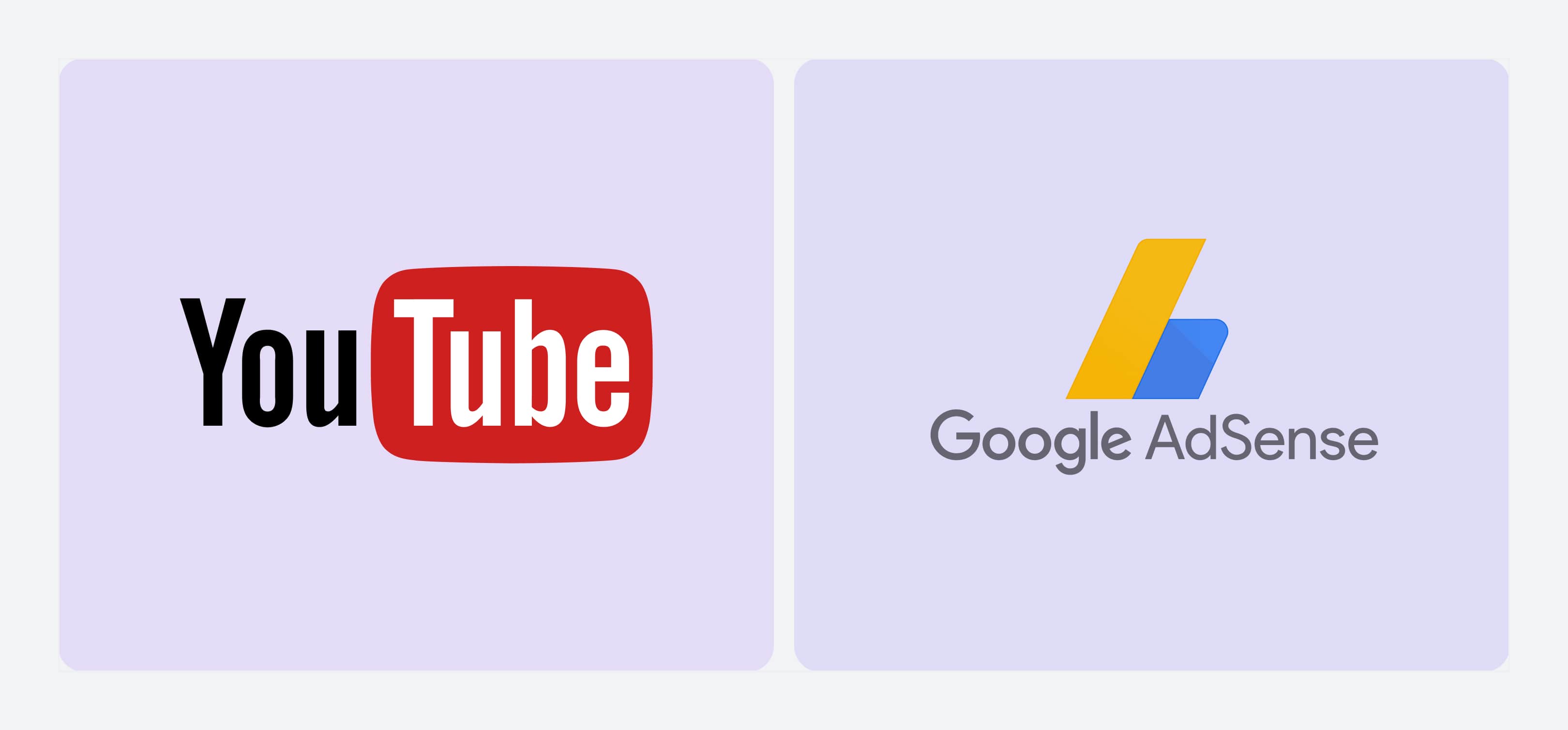
AdSense is YouTube’s built-in ad platform. Once you join the YouTube Partner Program (YPP), your videos become eligible to display ads through AdSense. These can include skippable ads, display banners, or mid-roll ads, depending on video length and viewer behavior.
Here’s the deal: YouTube sells those ad placements to advertisers. You, the creator, get a cut. It's usually 55% of the revenue. YouTube keeps the other 45%.
But not every view pays. Only monetized views count. That means:
- The viewer didn’t use an ad blocker.
- The advertiser paid enough to show an ad to that viewer.
- The viewer watched long enough for the ad to “count."
How to qualify for the YouTube Partner Program in 2025
To start earning through AdSense, you need to get into the YouTube Partner Program (YPP). That’s how you unlock monetization features like ads, memberships, and Super Chats.
As of 2025, YouTube offers two different paths to qualify:
- Traditional requirements: 1,000 subscribers and 4,000 valid public watch hours in the last 12 months.
- Shorts-based monetization: 1,000 subscribers and 10 million valid public Shorts views in the last 90 days.
No matter which path you take, you also need to:
- Follow all YouTube monetization policies
- Have no active Community Guidelines strikes
- Enable two-step verification on your Google account
- Live in a country where YPP is available (this includes the U.S., most of Europe, Latin America, and Asia)
Once you hit the threshold and apply, YouTube will review your channel. If you’re approved, your videos will start serving ads (and you’ll start earning).
Below, we've created a YPP checklist you can run through before you apply:
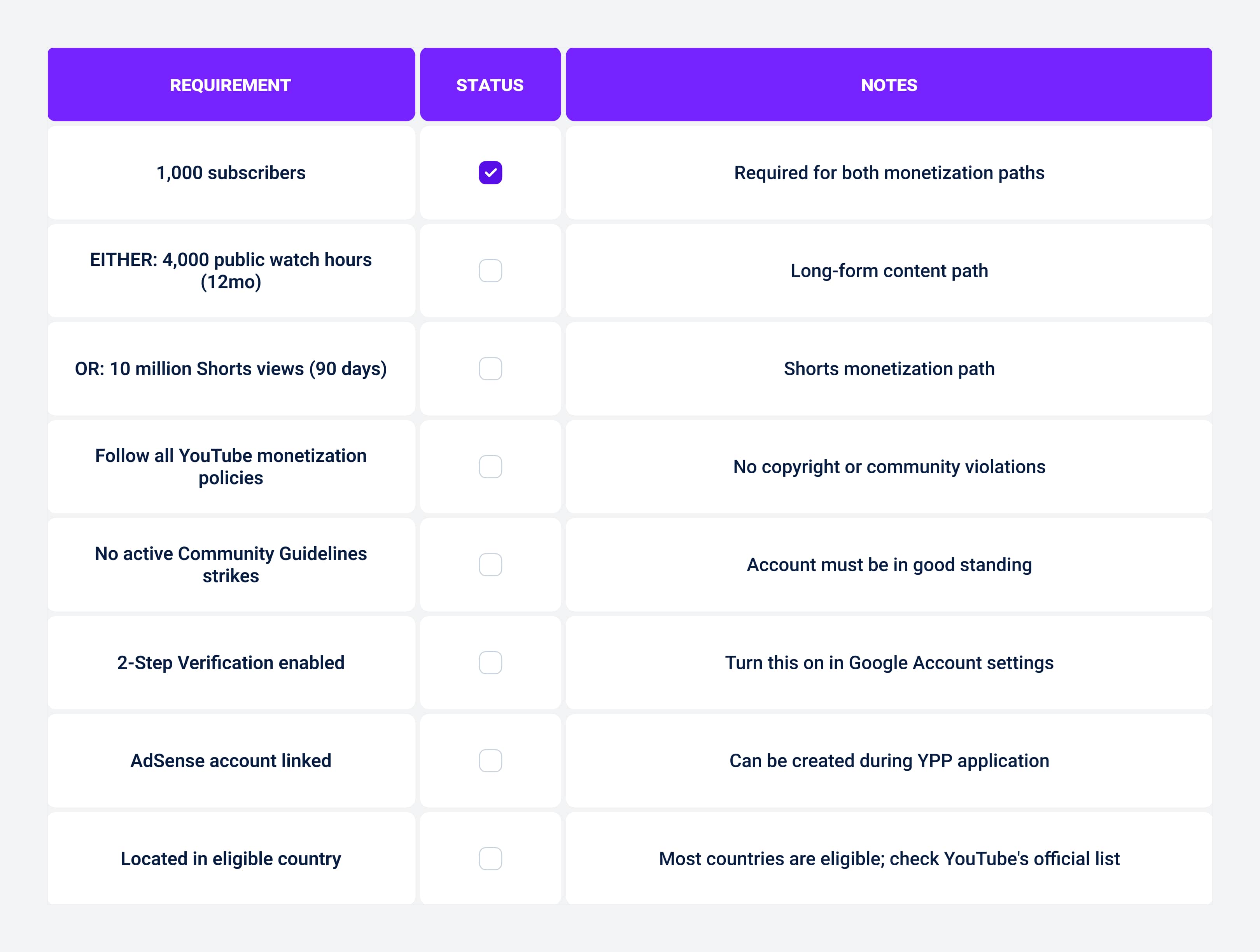
For more details, check out Google's official Partner Program overview and eligibility page.
Applying to and joining the YouTube Partner Program
Once you know you're in good shape, you can go through the actual process. It's pretty straightforward; here are the steps:
- Head to the AdSense website and click Sign up. Use the Google account that's also connected to your YouTube account.
- Fill out your details. They'll ask you for your YouTube channel URL, where you live and bank, account type (choose “Individual” unless you’re a registered business), the name and address on your legal ID, and your phone number (for verification).
- Wait for approval. This usually takes a few hours, but sometimes it can take a couple of days.
- Set up your payment info (after approval). Submit tax information (based on your country’s laws), link a bank account for payouts, and then Google will send a small test deposit (under $1) to confirm your bank details.
IMPORTANT NOTE: YouTube only allows one AdSense per person/entity. Do NOT create multiple, or YouTube will reject them as "duplicate accounts."
Understanding CPM, CPC, and RPM
Once you start making money on YouTube, you’ll see CPM, CPC, and RPM in your analytics dashboard. These are your most important considerations as a YouTube creator because they directly impact how much you can make.

CPM (cost per mille)
CPM is how much advertisers pay per 1,000 ad impressions. For example, if an advertiser pays $10 CPM, that means they’re willing to pay YouTube $10 to show their ad 1,000 times.
CPM gives you a ballpark of how “valuable” your audience is to advertisers. Niches like finance, tech, and business often get much higher CPMs (think $15–$25+) than lifestyle or gaming (often under $5).
Here's a look at YouTube CPM rates by category:
| Category / Niche | CPM (USD) |
|---|---|
| Low Shorts RPM | $0.02 |
| Typical Shorts RPM | $0.09 |
| High Shorts RPM | $0.15 |
| Music | $1.36 |
| Entertainment / Pets & Animals | $1.82–$2.74 |
| Gaming | $4.23–$4.55 |
| People & Blogs / How-To & Style | $6.36 |
| Education | $9.09–$9.89 |
| Photography & Filmmaking | $7.31 |
| Lifestyle | $3.47 |
| Fashion | $3.13 |
| Cooking | $2.50 |
| Make Money Online | $13.52 |
| Social Media Marketing | $12.41 |
| Finance & Investing | $12.25 |
| Digital Marketing / Finance | $14.55–$36.36 |
CPC (cost per click)
CPC is how much advertisers pay when a viewer clicks on an ad. The CPC metric usually applies to display and overlay ads, not skippable videos. It’s less predictable but can sometimes lead to spikes in earnings if your content drives a lot of engaged clicks.
While CPC isn’t the main driver of revenue on YouTube, it contributes to your overall earnings and can fluctuate a lot based on audience intent.
RPM (revenue per mille)
RPM is how much you actually earn per 1,000 views on your channel. This is the most important number for creators.
RPM = (Total revenue ÷ Total views) × 1,000This includes all income sources: ads, memberships, Super Chats, and so on.
RPM shows the real value of your channel. Even with a high CPM, your RPM could be low if few viewers see ads or interact. Most creators see RPMs in the range of $1–$5, but that number can grow significantly with the right content and audience.
GROW YOUR INSTAGRAM FOLLOWING VIA OUR CELEBRITY CAMPAIGNS
Leverage the power of the worlds A-list celebrities to grow your Instagram every month
VIEW CAMPAIGNSHow YouTube pays creators
AdSense pays creators once per month, sometime between the 21st and 26th. But there’s a catch: your balance has to hit the minimum payout threshold of $100 USD (or the local equivalent).
If you don’t hit $100 this month, your earnings roll over to the next. Once you pass that mark, you’ll be paid during the next cycle.
YouTube shares revenue with creators, but not evenly:
- You get 55% of the ad revenue.
- YouTube keeps 45%.
This cut applies to most types of ad placements, including in-stream video ads and Shorts ads. So if your video generates $1,000 in ad revenue, your cut is $550.
YouTube income is considered taxable. AdSense doesn’t automatically withhold taxes for most creators, so you’re responsible for filing and paying them based on your country’s laws. (For U.S. creators, you’ll get a 1099-K form if you earn $600+ in a year.)
Ad revenue
This is the first revenue stream most creators tap into. You post a video. YouTube places ads on it. If a viewer watches the ad (or can’t skip it), you earn money.
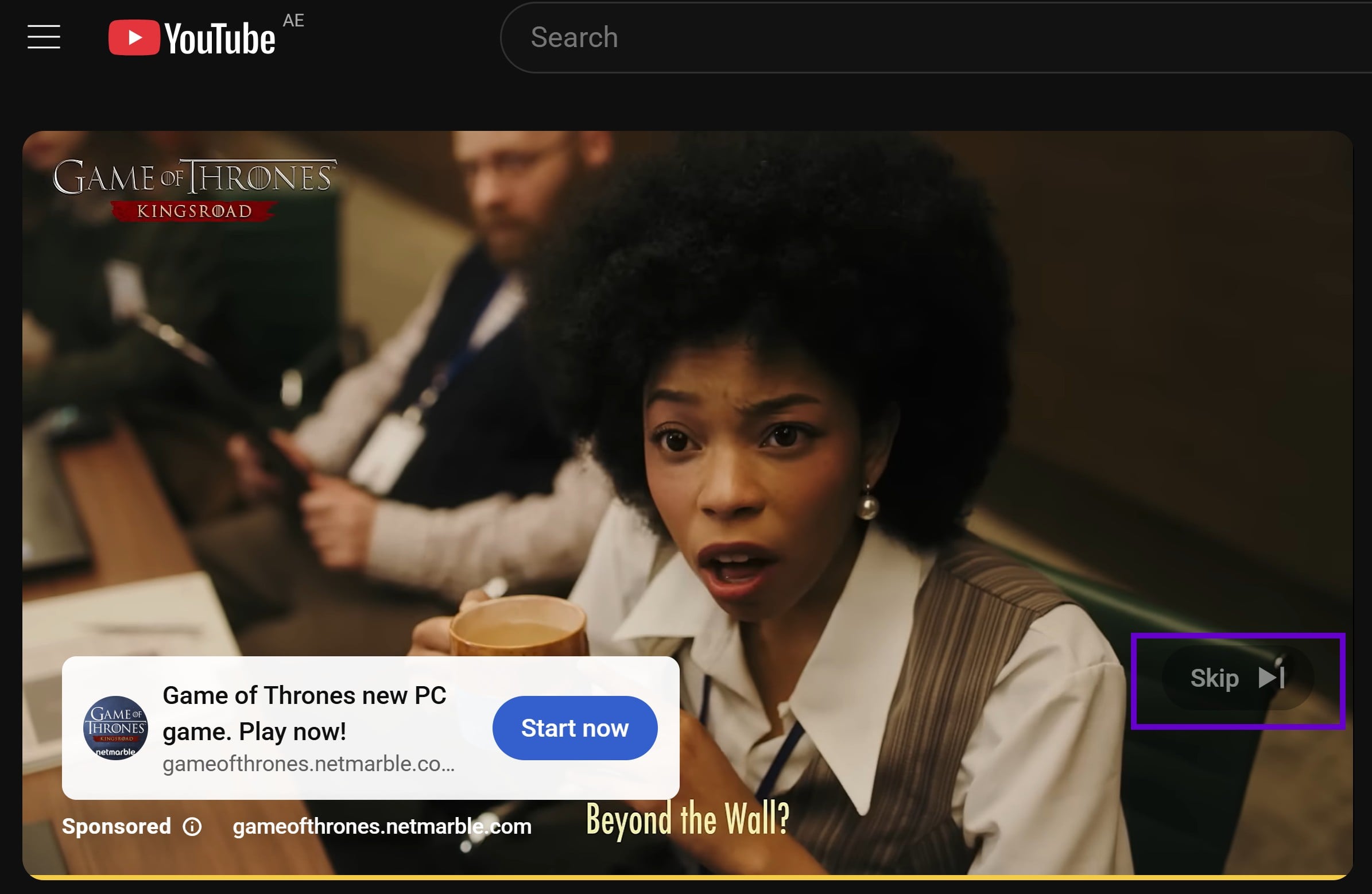
Here’s how it breaks down:
- Skippable ads pay only if the viewer watches at least 30 seconds (or the full ad, if shorter) or clicks on it. If they skip before that? You earn nothing.
- Non-skippable ads (15–20 seconds long) must be watched in full, so they guarantee a payout every time they appear.
- Bumper ads (6 seconds, non-skippable) also pay out every time they’re shown—but typically at lower rates.
- Overlay and display ads (desktop-only) pay when someone clicks on the ad, so they’re CPC-based, not view-based.
AdSense rewards watch time, viewer engagement, and content that’s brand-safe. If you’re making family-friendly, advertiser-friendly content that keeps people watching, AdSense can generate a healthy stream of passive income.
Affiliate marketing
Affiliate marketing is one of the most powerful (and underrated) ways to earn money on YouTube, especially if you’re in a niche with relevant products or services your audience could actually use.
- You recommend a product.
- Drop a custom affiliate link in your video description.
- When someone clicks and makes a purchase, you earn a commission.
For instance, travel YouTuber Drew Binsky partners with NordVPN. In the middle of his long-form videos, he frequently pauses for a “commercial break” where he promotes them and presents a promo code for a new user discount.
And he places the affiliate link in his description, so it’s easy to find and click at any point.
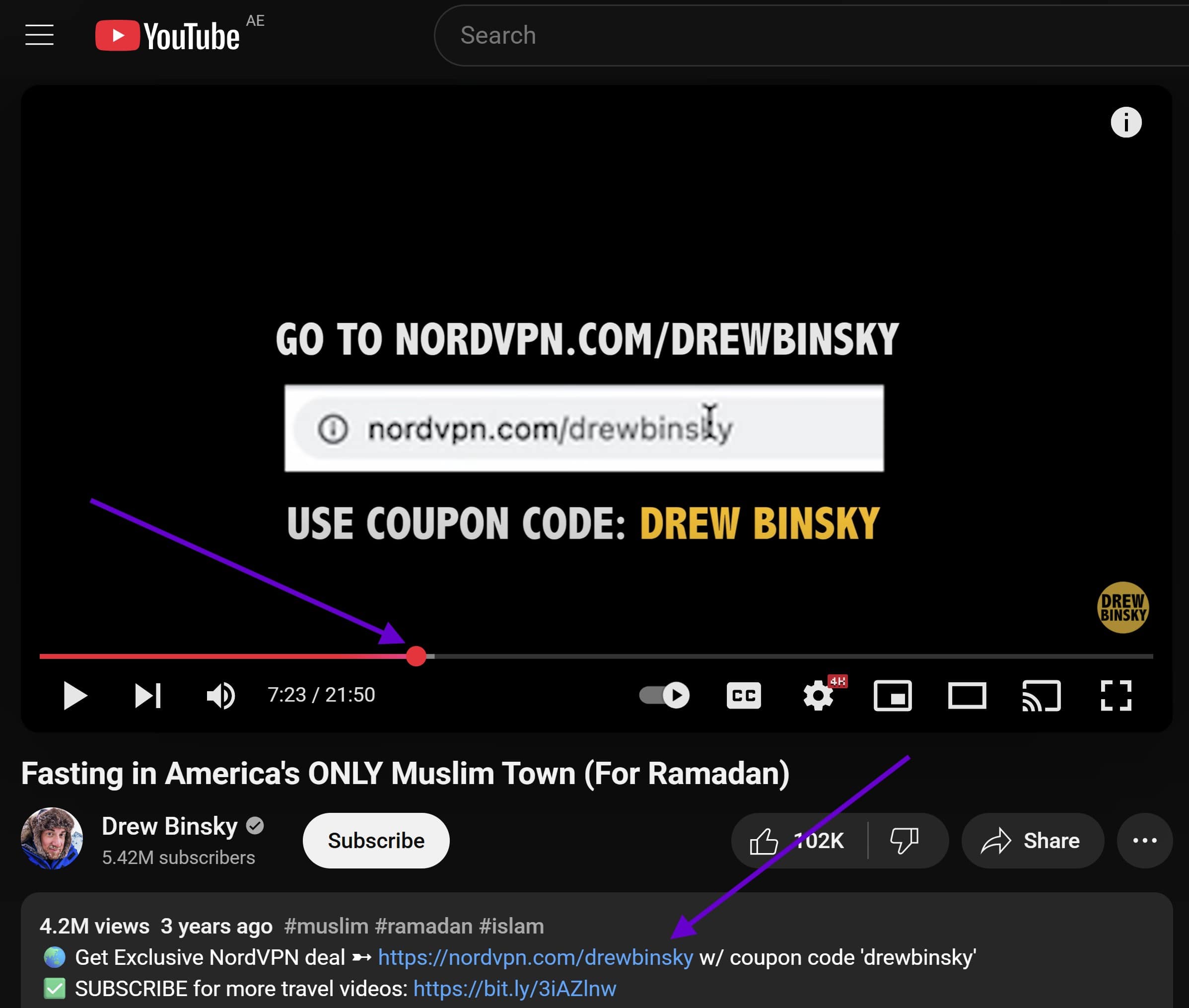
Unlike ad revenue, this has nothing to do with YouTube’s platform. You can start using affiliate links before you even qualify for monetization.'
Pro tip: Become an affiliate partner for SaaS products and subscription services with rev share deals. That way, every conversion gets you paid on a recurring basis.
Merchandise and product sales
Selling merch is the most direct way to turn fans into paying customers. If you have a loyal audience, they’ll want to support you by wearing your brand or slogans.
- T-shirts with catchphrases or logos
- Mugs, stickers, and accessories
- Limited drops or seasonal collections
- Digital products like eBooks or wallpapers
Products like these make viewers feel more connected to you, your mission, and values.
YouTube makes it easy by integrating with platforms like Spring, Spreadshop, and Shopify. If you're eligible, your products can even appear right within your channel page in a store called the Merch Shelf. This lets viewers browse and buy without even leaving the video page.
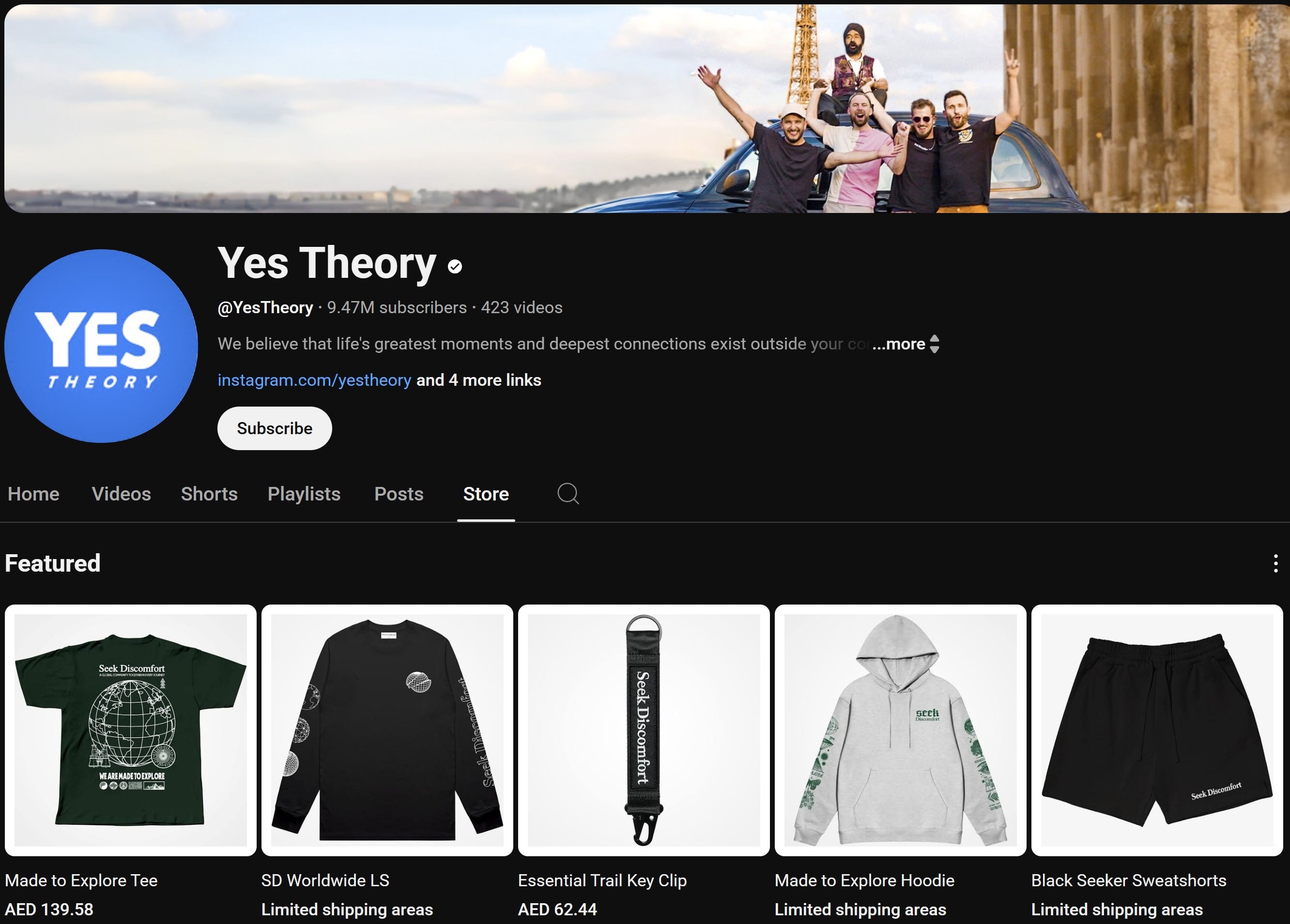
Super chats, memberships, and donations
Once you’ve built an engaged community, your audience can actually pay you directly; no brand deals or affiliate links required.
YouTube offers a few built-in features that let fans support you with their wallets:
- Super Chats and Super Stickers: These are available during live streams and Premieres. Viewers can pay to have their messages highlighted or send fun animated stickers.
- Memberships: Once enabled, you can offer your audience a subscription (usually starting at $4.99/month) in exchange for perks like exclusive badges, members-only posts or videos, private livestreams, and early access to content.
- Direct relationships: While YouTube takes a cut of Super Chats (30%), lots of creators also set up external donation and membership options through platforms like Patreon, Ko-fi, Buy Me a Coffee, and even PayPal.
These features won’t make you rich overnight, but they do turn audience loyalty into real revenue.
Selling courses or digital products
The highest-leverage revenue stream on YouTube? Selling your own stuff. When you sell a course, template, guide, or any kind of digital product, you keep 100% of the profit (minus platform fees).
- If you're an educator or niche expert, make free videos, then funnel your viewers into a paid offer that goes deeper into the topic.
- If you're in tech, coding, or software, build and sell code snippets, starter kits, dev tools, or automation templates (Zapier, Make, Google Sheets).
- If you're in fitness or wellness, create workout programs, nutrition guides, meal plans, or macro trackers. Or, launch a private community with exclusive coaching or video content.
- If you're a creative (artist, musician, designer), sell digital prints, sheet music, or LUTs, then create a course on your creative workflow or how to monetize your art.
Start by answering this: “What problem does my audience ask me about most?” Chances are, you'll find it in the comments.
Then turn that into a product that saves time, solves frustration, or delivers transformative results.
Top factors that influence YouTube earnings
Not all YouTube channels are created equal. So, neither are their paychecks. Two creators with the same number of views can earn wildly different amounts depending on a few key variables:
Niche selection
Choosing the right niche can make or break your YouTube income, not just in terms of ad rates, but also in the monetization opportunities it unlocks. Some niches offer multiple layers of profitability.
Take tech, for example: If you review high-ticket gadgets, you’re not just earning from ads. You can stack on affiliate commissions from products that cost hundreds or thousands of dollars. A single video that ranks well or goes viral could bring in recurring income from clicks and purchases for months.
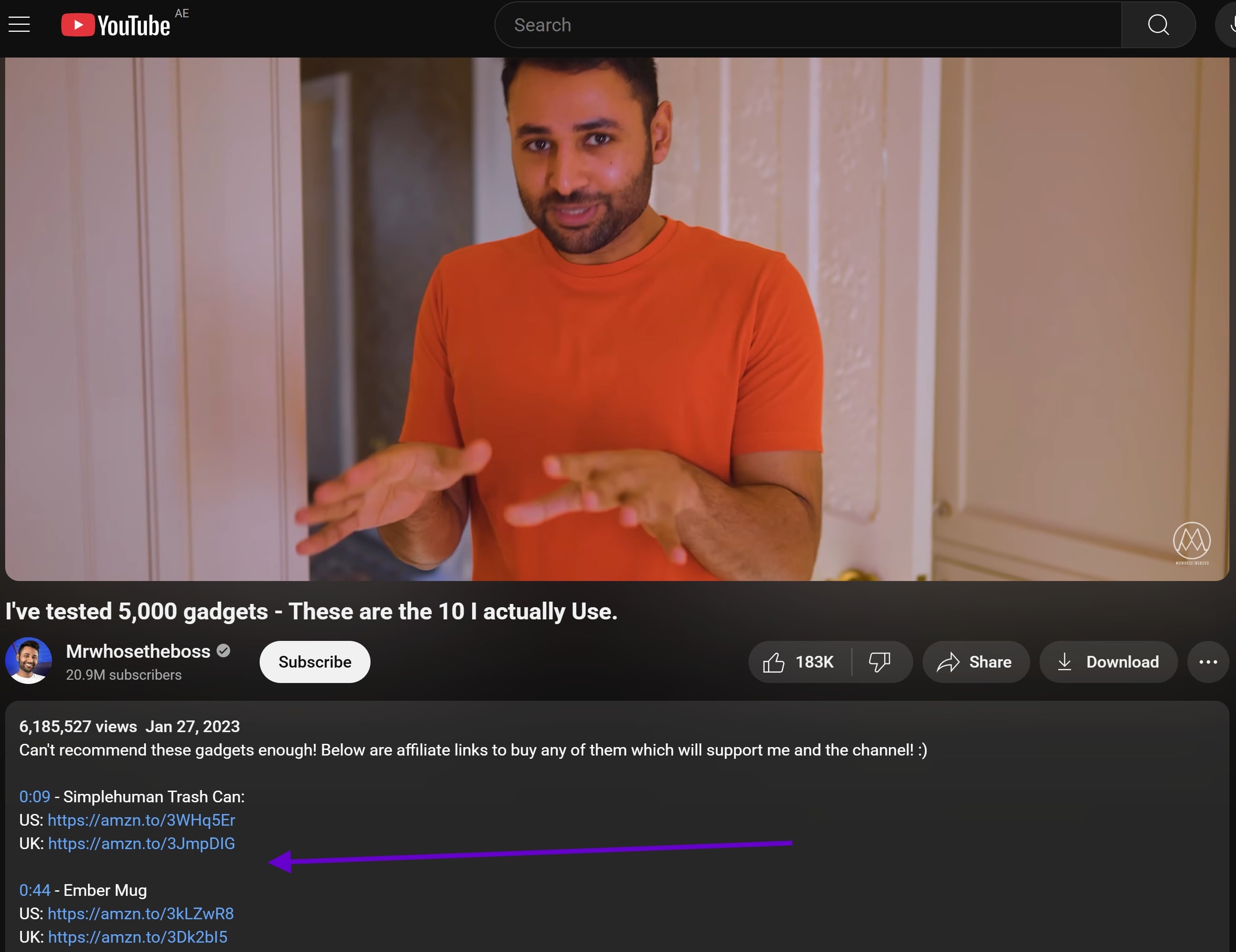
Finance, investing, and B2B content (marketing tools, SaaS platforms, workflow automation) are other examples. CPMs here range from $12 to $30+ and the content you'll naturally publish actively helps people make or manage money. So, there's a clear ROI for the viewer.
That means advertisers are willing to spend more and you can promote high-ticket offers that convert well.
Audience demographics
Where your viewers live plays a big role in your revenue. Audiences in the U.S., Canada, U.K., and Australia typically generate higher ad rates than viewers in regions like Southeast Asia, Latin America, or Eastern Europe.
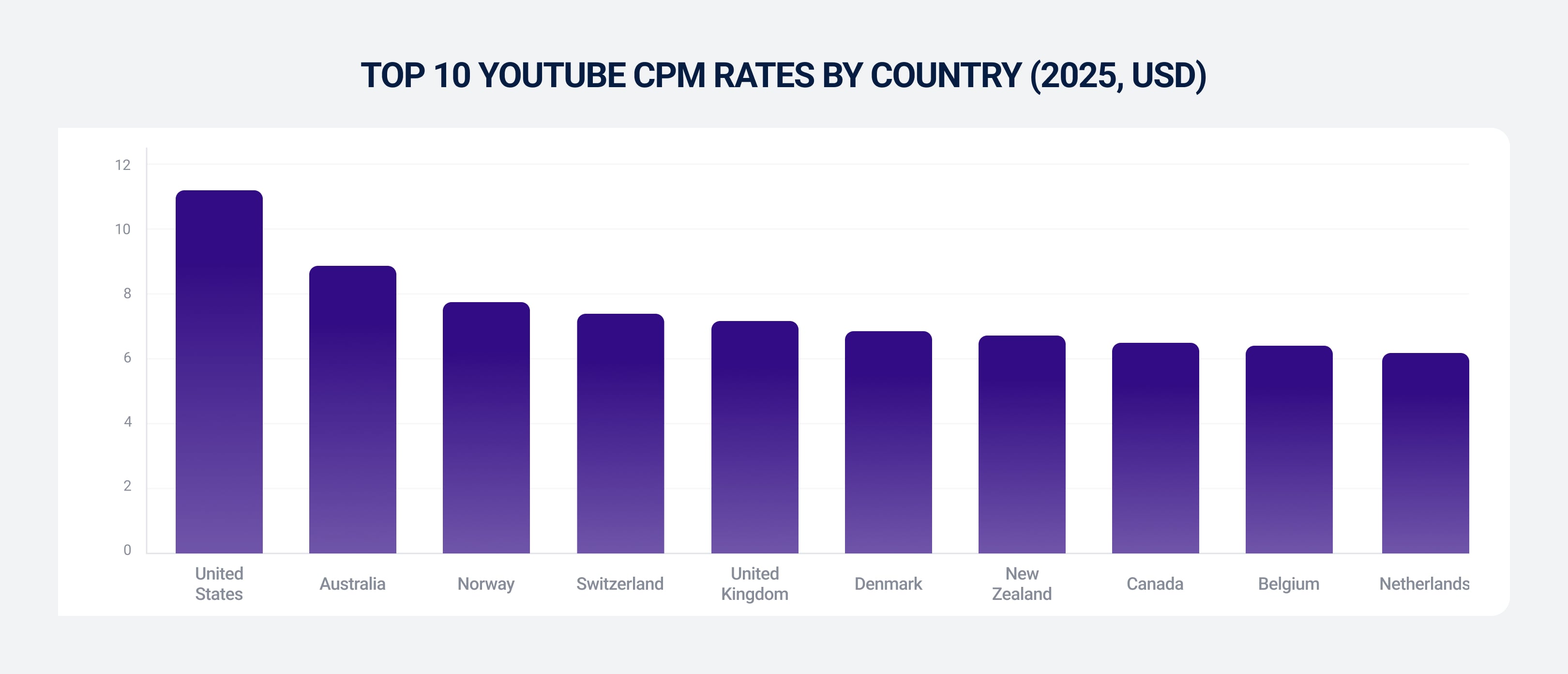
Age matters too. Advertisers love viewers aged 25–45 because they're the prime spending demographic. If your audience skews younger (13–17), expect lower RPMs.
And of course, disposable income makes the biggest difference. B2B execs have thousands to spend on one coaching or agency offer. Your average Gen Zer uses their discretion on anything over $50.
Video performance
YouTube rewards videos that keep people watching. High retention = more watch time = more ads served = more money.
Also, longer videos (8+ minutes) can include mid-roll ads, which boost your ad revenue significantly. A 3-minute video might get one ad. A 12-minute video could support three or four.
Channel size
More subscribers means more views—but it also unlocks more monetization tools.
- At 1,000 subscribers, you can join YPP.
- At 10,000+, you qualify for YouTube Shopping and brands start taking notice.
- At 100,000+, sponsorship deals open up and you can really start pushing your own products.
Size alone isn't the only variable, though. Engagement and potential earnings per viewer matter too.
For instance, you could have a channel with 5k subscribers in the "make money online" niche. If you launch a $1,000 course and just 1% of your audience buys it, you've made $50,000 with practically zero overhead.
YouTube earnings data, case studies, and analytics
When it comes to YouTube income, channel size definitely matters. But not in the way most people think.
A bigger subscriber count doesn’t always equal bigger paychecks. In fact, as your channel grows, your audience becomes broader, which lowers the average value of each viewer. That’s not a bad thing, but it does change how you monetize.
Small channels (1K–10K subscribers)
Smaller channels can punch above their weight in revenue per viewer. Why? Because they tend to have tight-knit, high-intent audiences.
For instance, YouTuber TCG Jake operates a tabletop gaming review channel with ~6k subscribers.
Despite the modest subscriber count, he mentioned on Reddit he earned approximately $9,000 from affiliate links in 2024, compared to $2,300 from YouTube ad revenue.

If you’re in a niche with expensive or high-ROI offers like investing, consulting, or software and you’ve built trust, you can earn a lot more even with a similar-sized following.
In one video, Greg Miroslaw documents the journey of one of his clients from 700 to 3,000 subscribers in 3 months. With that small follower count, in that short timeframe, they closed 20 clients at $5k, which equals $100,000 in new business.
Mid-tier channels (10K–100K subscribers)
This is the sweet spot for many creators. You still have the focus and loyalty of a smaller audience, but now you’ve unlocked new monetization tools:
- Brands will start approaching you for paid deals.
- You can package affiliate offers more strategically.
- You're a micro-influencer, which is incredibly appealing to advertisers looking for trust and relatability.
If you’re good at audience building and staying niche-focused, this tier offers diversification without dilution.
In 2023, Views4You ran a study on Phelous (Phelan Porteous), a YouTuber who, at the time, had 100,000 subs on the platform. He posts comedic reviews of bad horror movies, Disney-eqsue mockbusters, and knockoff products.
From AdSense, he earns about $4,550 per month. And he earns an additional $1,260 per video from sponsorships.
Since he uploads 3-4 videos per month, that's anywhere from $8,330 to $9,590 per month. And that doesn't account for his merch sales, the Google ads he hosts on his website, or his tiered Patreon community.
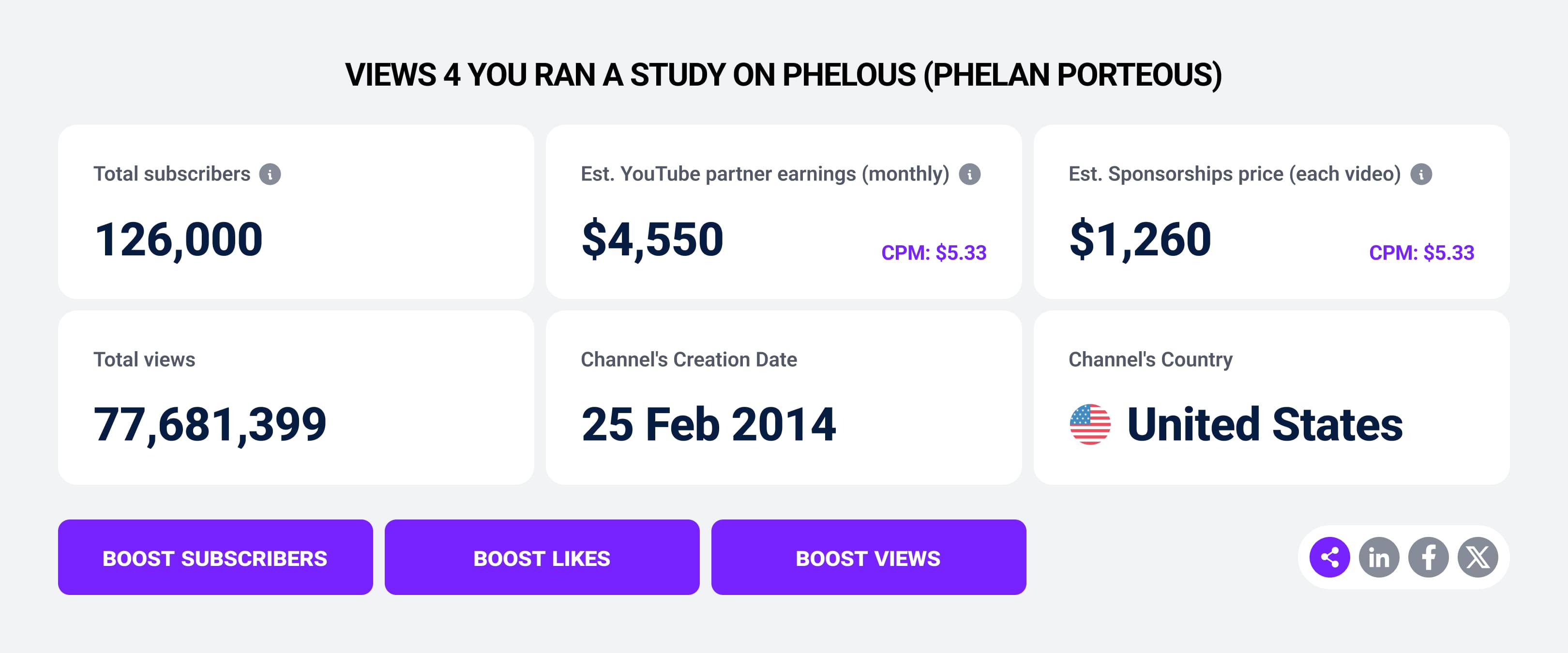
Top channels (100k+ subscribers)
At this level, you're operating a full-on creator business. Most high-level creators combine ad revenue, sponsorships, merchandise, affiliate marketing, and digital products to generate income from multiple angles. They also expand into other social media channels.
Yes, the upside is massive. But so is the complexity.
There’s also more traffic from outside your ICP. For example, Nomad Capitalist has more than 1 million subscribers and nets tens to hundreds of thousands of views on every video.
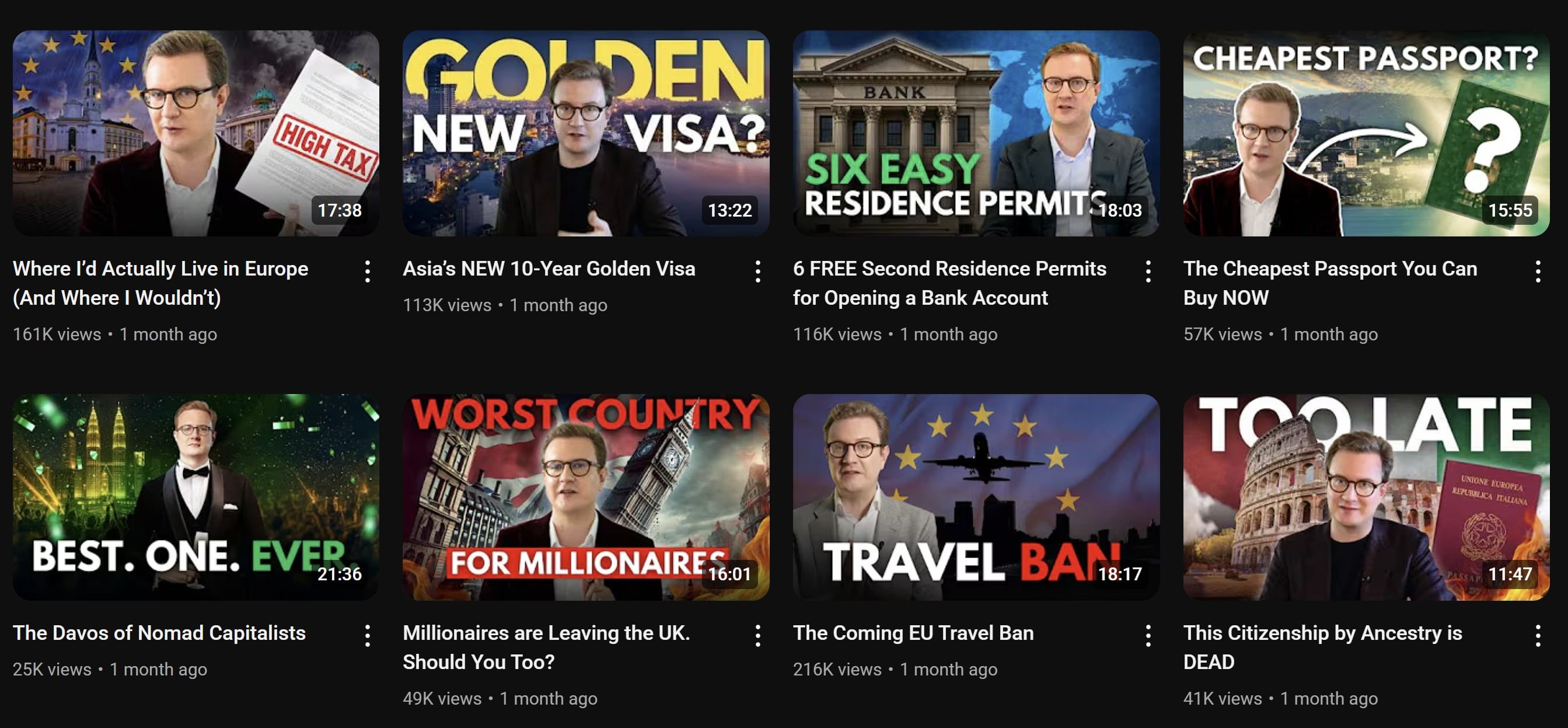
But his company's offer is targeted at high- and ultra-high-net-worth individuals looking to build international tax and investment structures.
Not every viewer is a fit, but the few who are? Worth a fortune.
YouTube earnings from AdSense
While CPMs and RPMs fluctuate, there are some reliable benchmarks to help you estimate what kind of income you might make from AdSense alone:
- Beginner (1,000 subs): $30 to $300/month
- Growth (100k subs): $1,000 to $3,000/month
- Established creator (1M subs): $10,000+ per month
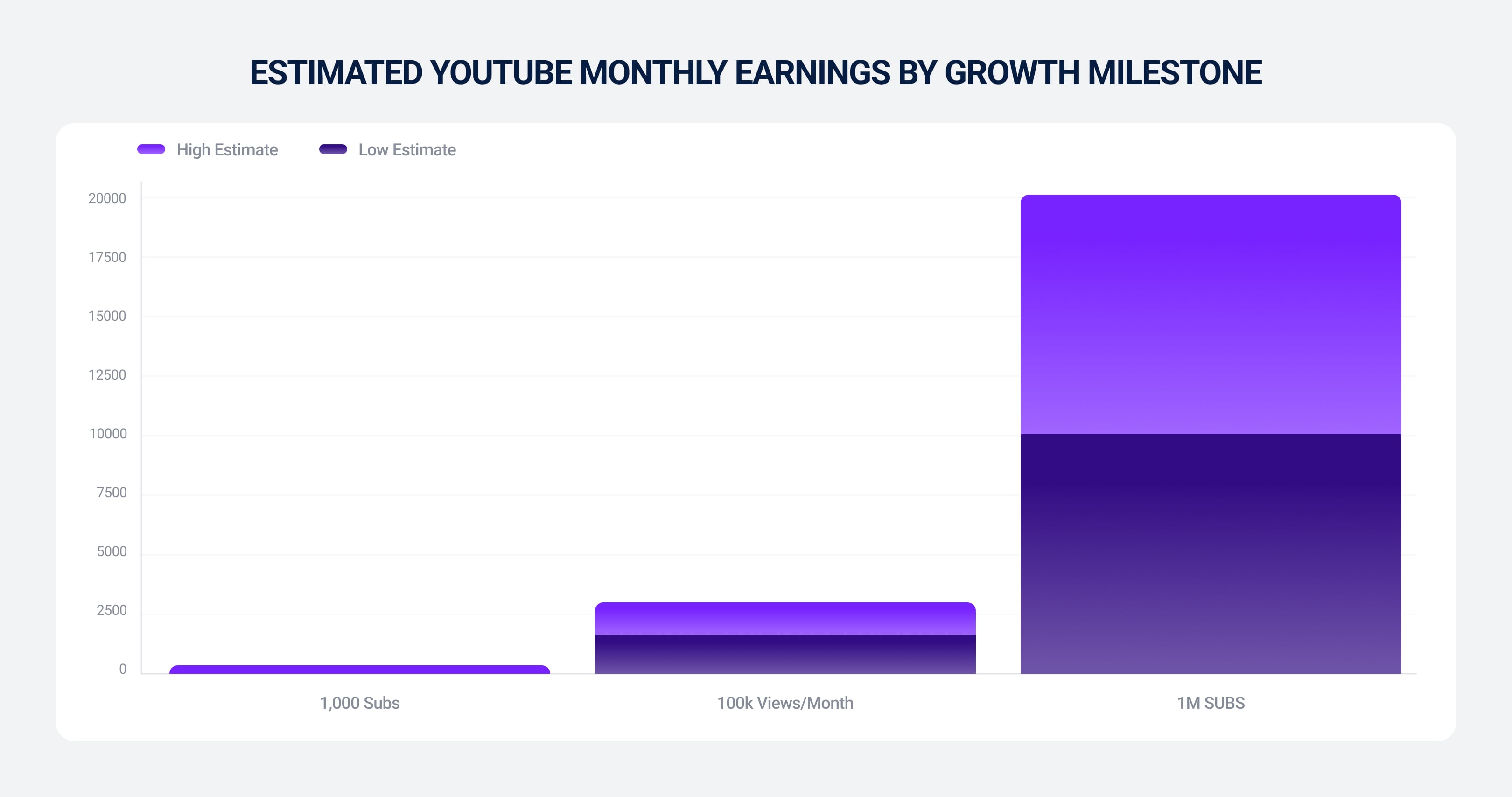
Overall, AdSense can scale, but only when you pair it with consistent output, smart strategy, and other monetization layers to support it.
Seasonality YouTube revenue trends
YouTube income isn’t consistent month to month. Like retail and advertising in general, seasonality plays a big role in how much you earn.
- Q4 (Oct-Dec) is peak ad spend season thanks to Black Friday, Cyber Monday, and holiday shopping. CPMs can spike 20–30% or more (in 2024, Sept-Oct saw a 67% average increase). Ecommerce, tech, and giftable products niches can go even higher.
- Q1 (Jan–Mar) is when advertisers slash budgets after the holidays. CPMs drop, sometimes by half compared to December.
- Q2 (Apr-Jun) sees moderate recovery because brands start ramping up campaigns (Easter, Mother's Day, seasonal launches) and companies have reviewed performance and set ad strategies.
- Q3 (Jul-Sep) sees lots of advertisers pause campaigns as consumers are less active and screen time drops. Back-to-school ads start late in the quarter, but they’re niche and don’t push CPM averages up much. As a result, August sees the lowest CPM of the year.
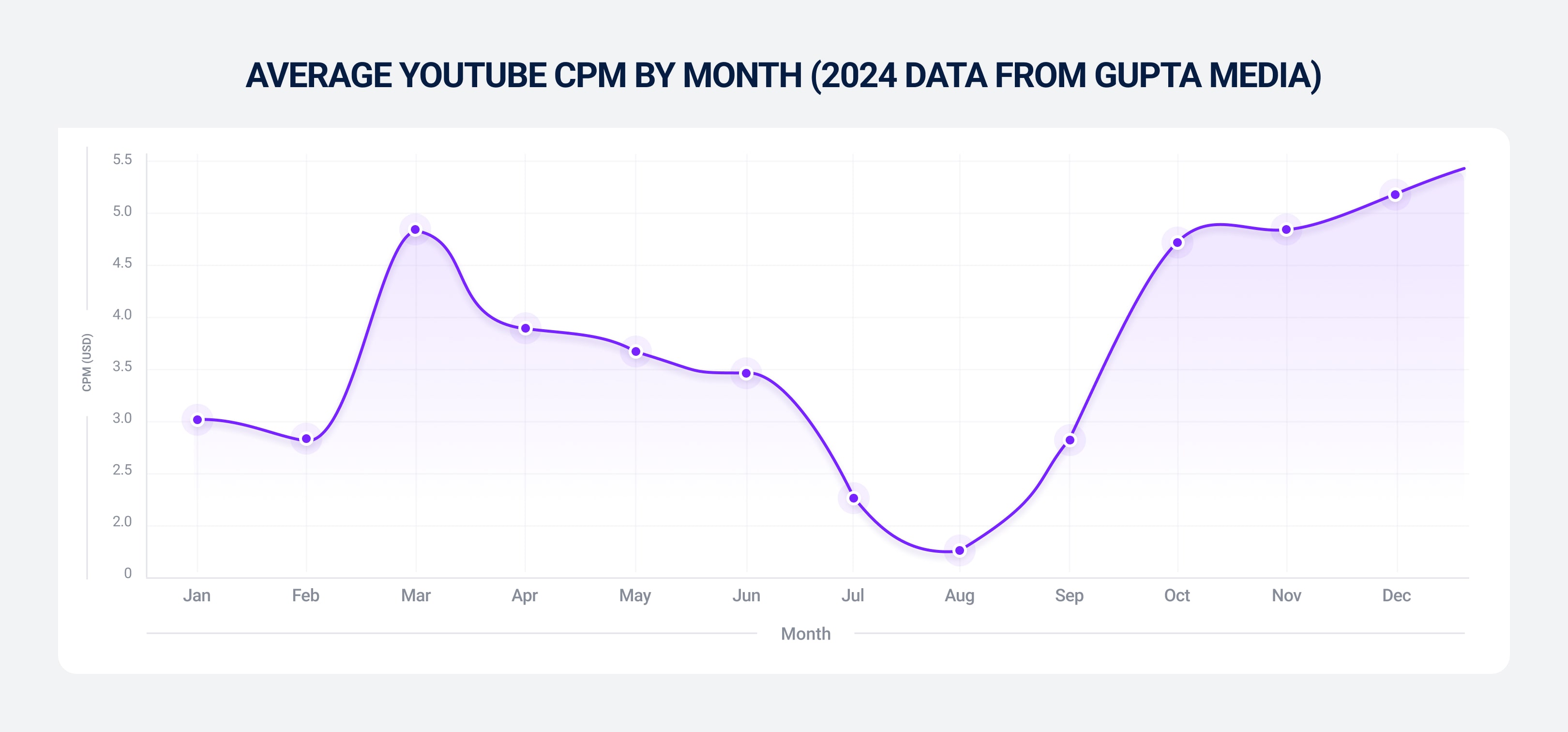
Pro tip: Diversify your income early. During low-CPM periods, focus on alternative monetization strategies such as affiliate marketing, merchandise sales, or fan funding.
Estimating your potential YouTube earnings
RPM is the most useful number for estimating earnings. It factors in both CPM and viewer behavior (like ad skipping or ad blocker use), and it already reflects your cut.
To calculate your earnings, the basic formula is:
Earnings = (Total views ÷ 1,000) × RPMIf your RPM is $5 and you get 50,000 views in a month:
(50,000 ÷ 1,000) × $5 = $250/monthIf you don't want to do the calculation yourself, there are plenty of free tools out there to help. They take your average views and estimated RPM or CPM to give you a ballpark monthly income.
Our favorites:
- Social Blade: Offers a general range of monthly and yearly earnings for any public channel. Good for basic estimates but tends to be overly broad.
- Noxinfluencer: Allows you to input channel data or look up other channels. Also breaks down CPM by country and niche.
- Influencer Marketing Hub: Easy to use and great for testing different RPM scenarios. Especially helpful for newer creators.
- YouTube Money Calculator by Sellfy: Designed for digital product creators, this one adds insights on how much you could make selling products alongside your content.
Note: This is how you estimate earnings from the YouTube platform. To estimate total earnings across affiliates, product sales, etc., you're going to have to use attribution modeling, add up the YouTube-sourced income from each revenue stream, then estimate based on your historical trends and growth trajectory.
Customizing estimates with your own data
If you want to be more precise, ditch the default inputs and start plugging in your actual channel data from YouTube Studio:
- Use your average RPM from the last 30 days.
- Grab your monthly view count, not just total channel views.
- Adjust for niche-specific seasonality (e.g., expect 20–30% higher RPMs in Q4).
- Exclude Shorts views if you're not monetizing Shorts via ad revenue.
You can also build your own spreadsheet in Google Sheets or Excel to model different RPM ranges, growth trajectories, and monetization stacks (ads, affiliate, products, etc.).
Small channel success stories
You don’t need millions of subscribers or a production team to make serious money on YouTube. Most of the most inspiring success stories come from creators who started small.
Imam Januar: From $132/Month to $2,570 first payout
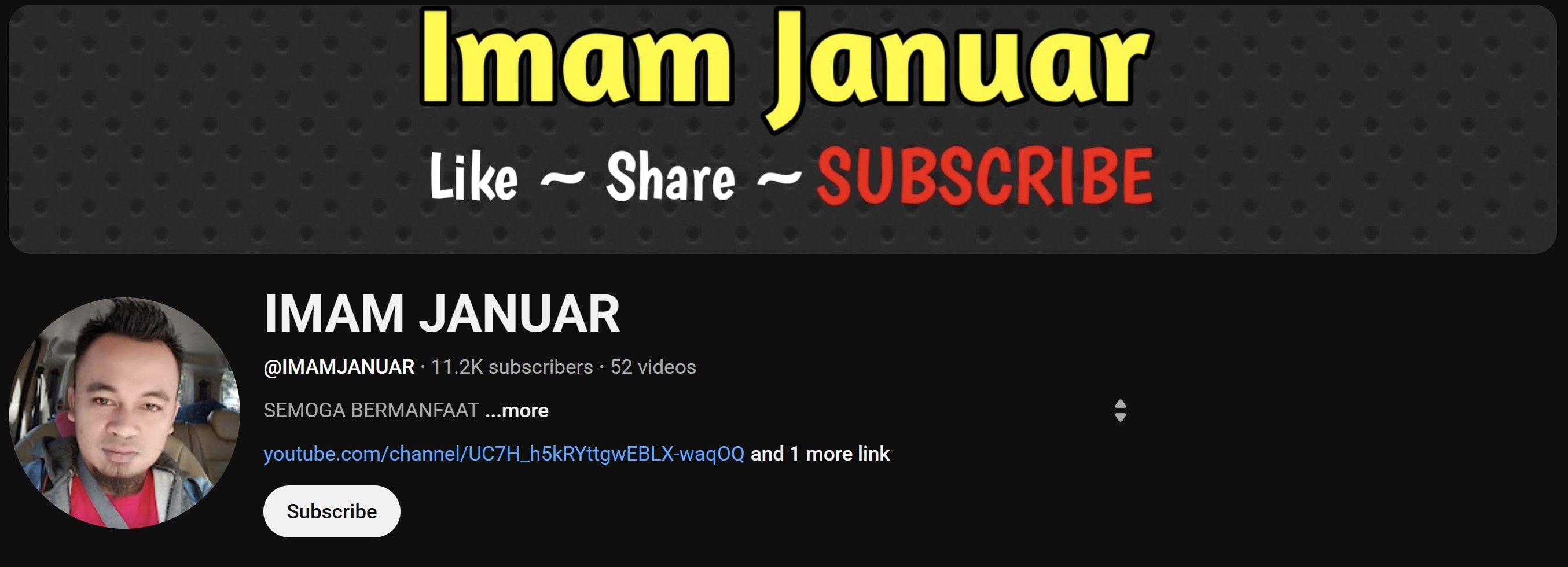
Location: Bondowoso, Indonesia
Started: 2017 with a Xiaomi Note 5 smartphone
Imam started uploading videos about herbal remedies and Islamic prayers, all from his village in Indonesia. His early earnings were minimal — just $132/month. But through consistency and niche focus, he eventually hit a breakout moment, earning $2,570 in his first big payout.
That income allowed him to quit his job, pay off debts, and reinvest in his community, helping others in his village become creators too. It’s a powerful example of what’s possible when you focus on serving a specific, underserved audience.
Made With Lau: $50,000/month teaching Cantonese cooking
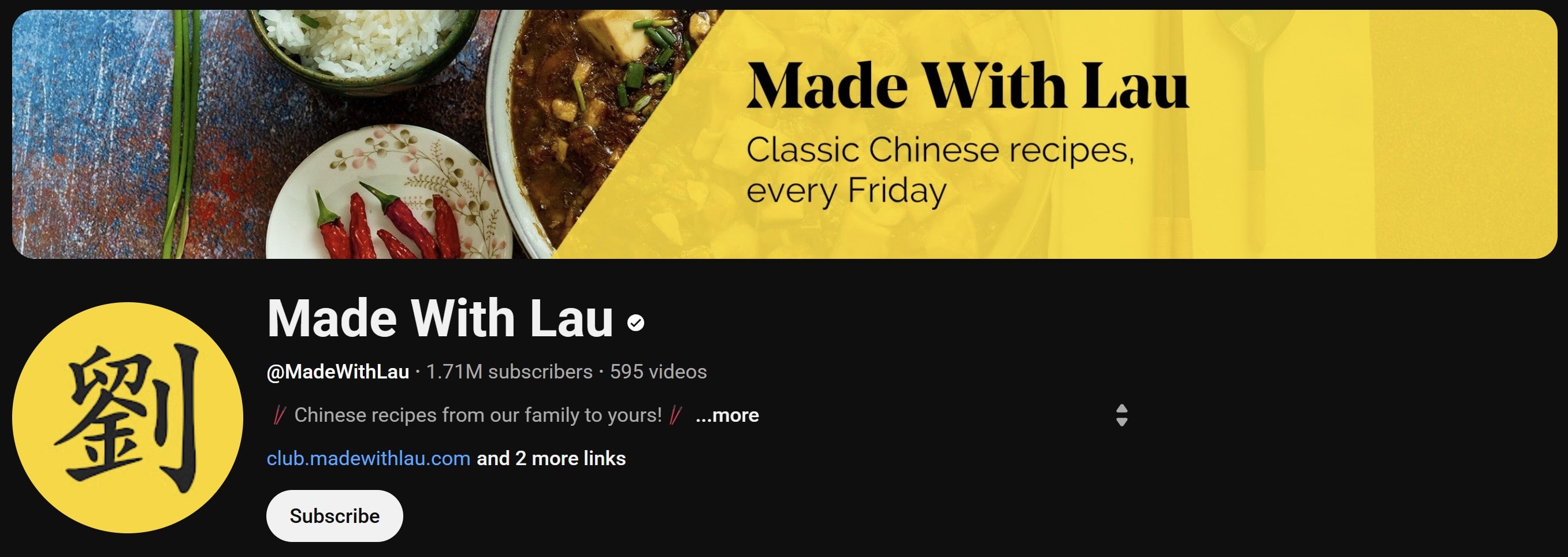
Launched: September 2020
Niche: Family-based Cantonese cooking tutorials
This wholesome family channel exploded in just a few months. They monetized in under 3 months, hit 1M subscribers by the end of 2022, and were earning $50,000/month by late 2021 from AdSense alone. Patreon and sponsorships.
Faceless channel: 261,000 subscribers with just 20 videos

Creator: Kristen Walters
Growth: 261,000 subscribers in 5 months
Kristen built a faceless channel by mastering SEO and high-retention video strategy. With just 20 videos, she pulled in over a quarter-million subscribers in under half a year.
Her secret? She focused on evergreen, searchable content that ranked well and kept people watching. This is proof that you don’t need to show your face or post constantly—you just need to post strategically.
Costs of running a YouTube channel
Like any business, there are real costs involved in producing high-quality content, growing your channel, and keeping everything running smoothly.
Like any business, there are real costs involved in producing high-quality content, growing your channel, and keeping everything running smoothly.
Let’s break down the typical expenses you should expect as a creator.
Equipment
You don’t need a Hollywood setup, but some basic gear makes a huge difference.
- Starter setup ($100–$500): Smartphone, tripod, basic ring light
- Intermediate setup ($500–$2,000): DSLR/mirrorless camera, shotgun mic, softbox lighting
- Pro setup ($2,000+): Multi-cam rigs, lav mics, green screens, upgraded lenses
Editing software and tools
Whether you're editing yourself or outsourcing, you'll need tools.
- Free options: iMovie, DaVinci Resolve
- Paid tools: Final Cut Pro, Adobe Premiere Pro, CapCut Pro
- Thumbnails/graphics: Canva Pro, Photoshop
- Music licensing: Epidemic Sound, Artlist, or YouTube Audio Library
When you're starting out, you're looking at $0–$50/month depending on your setup.
Time (or outsourcing)
Time is your biggest cost. If you’re not editing yourself, expect to pay:
- Video editing: $50–$300 per video
- Thumbnail design: $5–$50 per thumbnail
- Scriptwriting or voiceover: $20–$200+ depending on length and quality
Some creators build a team as they grow. Others go lean and do everything solo (this is really only possible as a smaller creator). Either way, content creation is work.
Marketing and SEO tools
To grow effectively, you'll need to strategize your content based on what people are searching for and track your success. You'll need tools like:
TubeBuddy or VidIQ: Help you optimize titles, tags, and performance
Email tools: ConvertKit, MailerLite if you're building a list
Analytics dashboards: Advanced YouTube analytics, audience segmentation tools
For these tools, you're looking at another $10–$50/month for beginner-level tiers.
How we'd do it: Start small, then reinvest as you grow. Most creators begin with a $300 setup and cheap software, then build a full-time income before ever spending big.
How to maximize your YouTube earnings
Views are just the starting point. If you want to turn YouTube into a serious income stream (or even a six-figure business), it’s all about working smarter, not just harder.
Here are seven proven strategies to help you squeeze more revenue out of every view, every subscriber, and every second of watch time:
Use the "8-minute rule" for mid-roll ads.
YouTube allows mid-roll ads on any video 8 minutes or longer. That means more ad placements = more revenue. Even adding one mid-roll can significantly increase your RPM.
That said, don't drag out a 5-minute video to make it 8 minutes.
But, if your content is in that 7 minute range, you can significantly increase your earnings by adding extra content to hit the threshold.
Optimize your whole marketing funnel.
Don’t rely on viewers to “figure it out.” You need a clear path. Let's say you're building a personal brand to drive traffic to an agency or info product.
Most viewers aren’t ready to buy on first contact. But if you capture their email with a free lead magnet, you can nurture them into paying clients over time without hard-selling on camera.
YouTube video → newsletter → value drip → high-ticket offerFor instance, Chase Dimond is a 7-figure email marketing agency owner who's become known across the internet for email marketing and copywriting. On YouTube, he publishes introductory content like this:

His CTA is usually to sign up for his newsletter, which you'll find in the description.

In his email newsletter, he drops one-off tips you won't find in his videos. And he uses that channel to sell his high-ticket agency, course, and consulting offers because those are his most engaged followers.
Have multiple offers for different viewers.
As your channel grows, your audience will diversify. You’ll have casual fans, high-intent buyers, and everything in between.
Instead of pushing one product to everyone, create:
- A low-ticket product for mass appeal
- A mid-ticket offer for serious learners
- A premium offer (or done-for-you service) for hot leads
This layered strategy helps offset declining RPMs by monetizing each viewer based on where they are in their journey.
Follow YouTube SEO best practices.
YouTube is the second-largest search engine. Treat it that way.
- Use keyword-rich titles that still feel human.
- Add keywords to descriptions and tags (without over-stuffing).
- Use a tool like TubeBuddy or VidIQ to find low-competition, high-search terms.
- Include natural language that viewers might search (e.g., “how to start a blog in 2025”).
Good SEO = long-term visibility and steady evergreen income.
Craft titles, thumbnails, and intros that hook.
Your thumbnail and first 5 seconds are make-or-break.
- Titles should be thought-provoking or surprising in some way.
- Thumbnails should be bold, clear, and emotionally charged. Think face + contrast + curiosity.
- Your intro should hook the viewer immediately. YouTube autoplays the first few seconds when someone hovers, so no fluff. No logos. Get straight into the video.
Take Mr. Beast for example. He doesn’t say, “This is my charity.” He says, “Watch this video to feed one person in need.” Big difference.

His titles are simple, but they present concepts so interesting that you have to see what they're actually about. And his thumbnails are dramatic, but reinforce the title with visual cues.
Boost your watch time and engagement
Watch time is king. The longer people watch, the more ads YouTube serves—and the more your video gets pushed.
To increase it:
- Open with curiosity (questions, bold claims, unusual visuals).
- Use pattern interrupts (camera changes, on-screen text, storytelling shifts).
- Tease future value ("Later in this video…").
- End with a strong call to action to another video in your library.
- Ask for comments and pin a question to encourage discussion.
Become omnipresent in your niche.
People trust what they see repeatedly. Show up everywhere:
- Create a free or paid community, or both (Discord, Circle, Facebook).
- Collab with others in your space by co-creating content and appearing on podcasts.
- Repurpose your videos on Shorts, Reels, TikTok, LinkedIn, and Twitter/X.
- Run retargeting ads to warm viewers who didn’t convert the first time.
This builds brand familiarity, deepens trust, and increases conversion opportunities, especially for your higher-ticket offers.
Common challenges of making money on YouTube
You’ve probably heard that making money on YouTube is “easy” if you just post consistently. But that’s surface-level advice. Truth is, monetizing YouTube is a long game and most creators run into roadblocks that no one warns them about.
These are the most overlooked (but important) challenges we see creators getting tripped up by:
High views ≠ high revenue.
If your content attracts a broad, low-intent audience—or if you're in a low-CPM niche—those views may be worth pennies. A channel with 10,000 targeted views in a high-value niche can make more from affiliate sales or a coaching funnel than a general channel with 1M views.
Algorithm volatility
YouTube’s recommendation algorithm is constantly evolving, and even the most experienced creators can’t fully predict what will pop. That’s why relying solely on the algorithm is a dangerous strategy.
Pro move: Build an email list, own your audience, and don’t put all your revenue eggs in one basket.
It's more work than it seems
Filming is just 10% of the job. The rest?
- Research
- Scriptwriting
- Editing
- Thumbnails
- SEO
- Community management
- Analytics
For solo creators, it’s a grind. And if you're outsourcing, that’s more cost and management overhead. Full-time creators frequently work 40–60+ hours a week, even if they're only uploading once or twice a week.
There's a reason fewer than 9% of YouTube accounts have 1,000 or more followers. That reason is a lack of consistency.
Content monetization challenges
Not all content is ad-friendly. Topics involving health, finance, politics, or anything “sensitive” can get limited ads or be demonetized entirely, even if your video is informative and clean.
How we'd work around this: Monetize those videos with affiliate links, sponsors, or your own products. Don't rely on AdSense for anything "risky."
To help you understand just how much you can earn at the top, we’ve sourced the ten highest-earning YouTube creators today.
| Rank | Name | Annual Earnings (USD) | Net Worth (USD) | Subscribers | Key Ventures |
|---|---|---|---|---|---|
| 1 | MrBeast | $82 million | $500 million | 394M+ | Beast Burger, Feastables, Amazon Prime series |
| 2 | Jake Paul | $34 million | $100 million | ~34M | Boxing, merch, sponsorships |
| 3 | Markiplier | $30 million | $45 million | ~37.4M | Gaming, merch, podcasts |
| 4 | Jeffree Star | $20 million | $200 million | ~15.7M | Cosmetics, real estate |
| 5 | Like Nastya | $18 million | $104 million | 127M+ | Kids content, brand deals |
| 6 | Vlad and Niki | $16 million | $100 million | 133M+ | Kids content, merchandise |
| 7 | Logan Paul | $15 million | $150 million | ~23.6M | Boxing, podcast, merch, PRIME Drinks |
| 8 | Ryan Kaji | $14 million | $100 million | ~38.5M | Toy reviews, merch, TV shows |
| 9 | PewDiePie | $12 million | $45 million | 110M+ | Gaming, merchandise |
| 10 | Ninja | $10 million | $50 million | ~23.8M | Gaming, streaming, endorsements |
Final thoughts and action steps
Only 0.0054% of YouTube channels have over 1 million subscribers, which is the common goal for lots of aspiring creators. The reality is, you don't even need to come close to that to make a solid income with it.
YouTube rewards creators who treat it like a business, stay consistent, and diversify how they monetize. Whether you're just starting with 1,000 subscribers or scaling a six-figure channel, this is what you can do today to get the ball rolling:
- Figure out your niche — ideally one that combines strong demand and monetization potential.
- Start posting consistently with a focus on retention, SEO, and watch time.
- Get monetized ASAP by joining the YouTube Partner Program once eligible.
- Build a value ladder: free lead magnets, low-ticket offers, high-ticket solutions.
- Test affiliate partnerships with products your audience already needs.
- Add email capture to your funnel so you're not at the mercy of the algorithm.
- Track your RPM and refine your content strategy based on what’s working.
- Think long-term; the creators who win are the ones who stay in the game.
Frequently Asked Questions
How much do YouTubers make per 1,000 views?
On average, creators earn $5 to $20 per 1,000 views (RPM), though this can range from under $1 to $30+ depending on the niche, audience location, and monetization strategy. High-CPM niches like finance, software, and B2B pay much more per 1,000 views than entertainment or lifestyle content.
How long does it take to start making money on YouTube?
It depends on your growth speed and monetization strategy. But for AdSense, you must meet the YouTube Partner Program requirements first: 1,000 subscribers and 4,000 public watch hours in the past 12 months or 10M Shorts views in the last 90 days.
For most creators, this can take anywhere from a few months to a year, though viral videos or strategic content can speed things up significantly.
Can I make money on YouTube without ads?
Absolutely. In fact, many creators earn more from alternative monetization methods, which include affiliate marketing, digital products or courses, sponsorships, channel memberships, merchandise, coaching, and consulting programs.
What is the average income for beginner YouTubers?
Beginner creators (1,000–10,000 subscribers) usually earn $30 to $300/month from AdSense, depending on views and niche. But with smart monetization (e.g., affiliates or digital products), even small channels can make $500–$2,000/month or more.
How much does YouTube take from Super Chats?
YouTube takes 30% of Super Chat and Super Sticker revenue. So if someone sends you $10 during a live stream, you’ll keep $7 and YouTube will keep $3. For larger creators, this adds up, but it’s still a valuable income stream if you livestream often.

